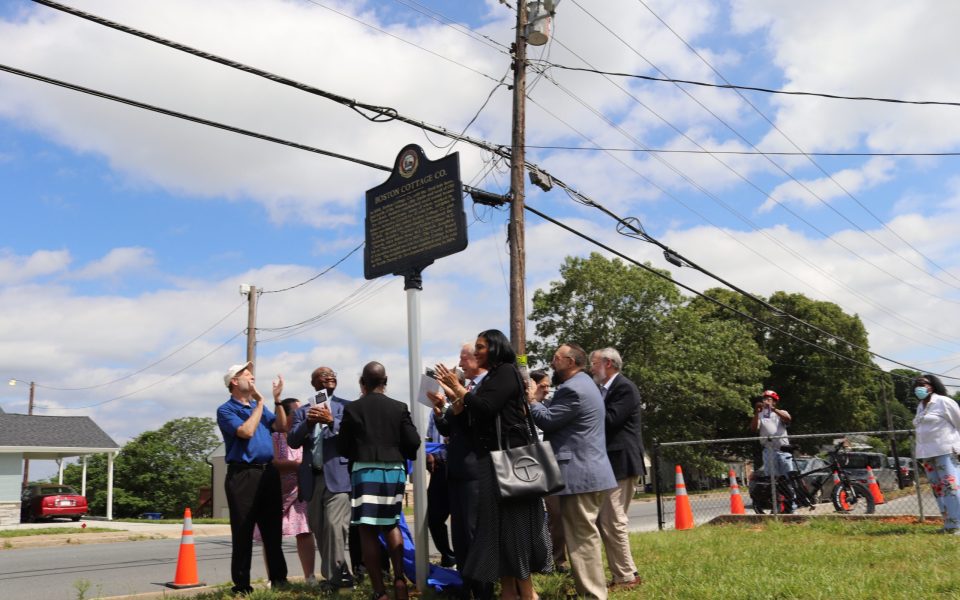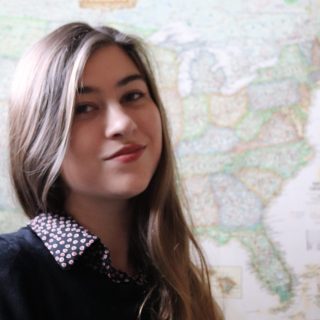Featured photo: The historic marker for the Boston Cottages was revealed on Saturday in Winston-Salem. (photo by Gale Melcher)
The harmonizing voices of the Saints Home Methodist Church Choir rang out on Saturday as city leaders gathered in the Boston-Thurmond neighborhood.
A vibrant community situated next to University Parkway in Winston-Salem, the neighborhood is one of the city’s oldest historically Black communities. The neighborhood has a rich history, and on Saturday a historic marker commemorating the Boston Cottages was unveiled in front of Saints Home United Methodist Church at the intersection of 14th Street and Thurmond Street, close to Paisley Magnet School.
The area derives its name in part from the Boston Cottage Company, which sold the first lots there in 1893. The subdivision was developed just outside city limits and cottages were constructed to be rented and owned predominantly by African Americans, many of whom worked in downtown tobacco factories.

The neighborhood’s resident-led leadership group Boston-Thurmond Community Engagement Roundtable applied for the historic marker through the Forsyth County Historic Resources Commission’s Historic Marker Committee, which recommends two markers a year to the city. Applicants can submit once a year with an annual submission deadline of Oct. 31.
Michelle McCullough, one of the city’s historic-resources officers, said that the community had been “planning and wanting to do it for years.” Sometimes people apply several times before being approved, but BTCER’s submission for the marker was approved the first time they applied, McCullough said.
President of BTCER Patricia Caldwell spoke at the ceremony.
“History provides us with a sense of identity. Without identity, who are we?” asked Caldwell.
“It gives us a sense of pride, who we are, and what we came from.”
Described as the neighborhood historian by McCullough, resident David West has lived in Boston-Thurmond for most of his life and is a member of BTCER.
“My family’s been here for over 100 years; my grandparents moved here in 1920,” West said.
‘We never forget’
Mayor Allen Joines, along with Mayor Pro Tem Denise D. Adams and councilmembers Barbara Hanes Burke, John Larson, Kevin Mundy and Jeff MacIntosh, attended the ceremony.
Adams grew up in the neighborhood.
“The only people that really know about where African Americans lived in the city are basically the Black folk that lived in the communities, and we never forget,” Adams said. “We can always tell you about our communities no matter how old we get, no matter what side of town we live on now.”
During the ceremony, Mayor Joines thanked Frank Elliott, the city’s director of marketing and communications. Elliott and his staff make city events like ribbon-cuttings, groundbreakings, and marker unveilings “go very seamlessly,” Joines said. Elliott retires in June.
Elliott was interviewed by WFDD in 2017 about the impact the city’s developing roadways have had on communities.
“Once this highway was built, it determined how Winston-Salem would grow for the next 50 years,” Elliott told the public radio station. “Because we had Business 40, we then got Silas Creek Parkway, we got the Salem Bypass, we got what they called the North-South Expressway which is now 52, we got Peters Creek Parkway, we got University Parkway.”
While the creation and expansion of roadways helped bring Winston and Salem together, they kept residents apart by cutting through the heart of thriving Black communities. The Boston-Thurmond area was flourishing by the 1920s, but construction of University Parkway in the 1960s dissected the original neighborhood from the North Cherry Street Historic District — an extension of the historic Boston Cottages neighborhood. Communities were split apart, and many of the homes were relocated or torn down for the highway construction.

West told TCB that University Parkway “certainly had an impact on the people that were in the direct path,” adding that some people’s houses fell off trucks while they attempted to relocate them. Only three cottages remain on Thurmond Street, according to the city.
“[City planners] thought they could do a twofer,” Elliott told WFDD. “They could get the road, and they could accomplish what they called ‘slum clearance.’”
Slum clearance is an urban renewal tactic that has often been used to convert low-income settlements into another type of development or housing. A historic structures survey report on Cleveland Avenue Homes discusses slum clearance in the city and how funding from the federal government under the American Housing Act of 1949 allowed the city to clear “slums and ‘blighted areas’ to erect racially segregated, affordable housing.”
“How much of that was a euphemism — ‘Well, we’ll put the road through their neighborhood so it doesn’t go through the white folks’ neighborhood’— and how much of that was sincere, I don’t know,” Elliott concluded.
According to a 2016 survey of the Boston-Thurmond neighborhood conducted by Forsyth Futures, residents reported that safety and access to grocery and food outlets were among their top concerns for the neighborhood. Sixty-seven percent said they would like to see single family housing as the neighborhood continues to grow, and 36 percent reported some form of worry or stress related to rent or mortgage. Additionally, 31 percent of residents said they had difficulty accessing healthy food due to a food desert, affordability, lack of transportation and distance to access fresh food, or limited community gardens.
The full marker text reads: “In 1893, Boston Cottage Co. sold the first lots here, just north of the Winston city limits and west of Old Town Road. Builders constructed small rental houses for African Americans, many of whom worked in tobacco factories. Except for 40 sold lots, Adolphus H. Eller purchased the entire Boston Cottage Co. plat in 1900. He sold lots individually throughout the following decades. Trustees of Boston Cottage M.E. Church, later Saints Home M.E. Church, bought a lot on Thurmond Street in 1900. The County Board of Education bought two lots for Boston Cottage School in 1901. The neighborhood was replatted and lots sold as North Cherry St. Development beginning in 1924.”
All CityBeat reporting content is made possible by a grant from the NC Local News Lab Fund, available to republish for free by any news outlet who cares to use it. Learn More ↗
Republish this storyJoin the First Amendment Society, a membership that goes directly to funding TCB‘s newsroom.
We believe that reporting can save the world.
The TCB First Amendment Society recognizes the vital role of a free, unfettered press with a bundling of local experiences designed to build community, and unique engagements with our newsroom that will help you understand, and shape, local journalism’s critical role in uplifting the people in our cities.
All revenue goes directly into the newsroom as reporters’ salaries and freelance commissions.


Leave a Reply